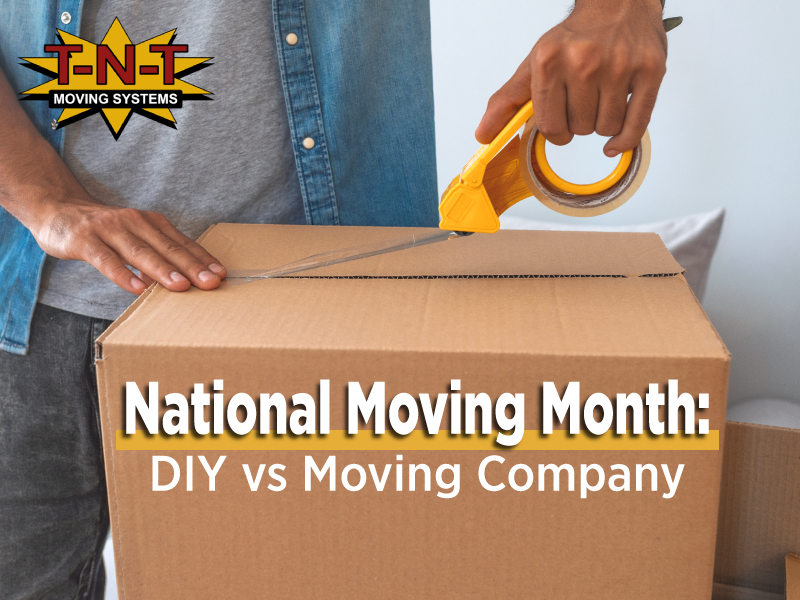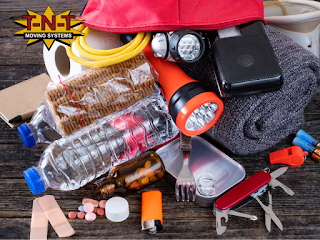
Did you know that June is Queen City’s busiest moving month? On top of that, it’s also National Moving Month! The months of April through September are when most people are renting, buying, and moving into new homes, with 80% of all moves in the United States occurring during this period.
When you’re planning to move, one of the biggest choices you face is whether to move yourself (a DIY move), go all the way and hire professional movers, or opt-in for a hybrid move. There’s obviously no wrong way to move, but choosing can come down to what you prioritize: money or convenience.
If you’re moving this month or this Summer, you need to book now! Book your Charlotte move with TNT Moving Systems! June is Charlotte’s busiest moving month and it’s National Moving Month, so moving company’s schedules are filling fast and you don’t want to be stranded without any help. Give TNT Moving Systems a call today to discuss your moving options and our availability.
Professional Movers VS DIY Move
- Full service move: This is the most convenient type of move, where the professional moving service is packing, loading, transporting, and unloading all of your belongings. Consequently, this is also the most expensive option.
- Hybrid move: A hybrid move can allow you to skip the portions of the move you can’t or don’t want to do (e.g. moving only heavy furniture, packing, loading the truck, only moving certain rooms), while saving some money as you opt to do some of the work yourself. This price can range as it’s entirely customizable to the services you choose, but typically falls at a mid-range price point.
- DIY move: A do-it-yourself (DIY) move is usually considered the most affordable option, as it’s assumed you are doing everything yourself for free, or have friends and family willing to help you at no cost. This is the least convenient method, as it relies on the time and effort of you and others, without the reliability or efficiency of a professional moving team.
Hiring movers for specialized services or a hybrid move
Professional movers can service moving trucks, trailers, portable moving storage containers, and tow-behind trailers. They also offer a variety of services that go beyond traditional packing, loading, truck service, and unloading.
Professional movers can focus on certain areas of your move. For example:
- Movers can only move furniture, without packing and loading all of your belongings
- Movers can focus on a specific room or set of rooms
- Movers can aid in moving specialized items to prevent damage
Professional movers can also be hired for on-site or in-home moves within a home, apartment, or complex. Some renters may have a lease run out in one apartment, but are living within the same building – we provide moving services no matter the type of move, or whether it requires the use of a truck or just a hand truck.
We see these types of services for on-site moves:
- When a home is being renovated and the owners need furniture moved around the home or relocated into storage units
- During the home staging phase, furniture and personal belongings are moved out to reduce clutter, or new staging furniture is moved in
- Donation or removal of unwanted furniture and items from a home
- Businesses moving offices within the same building or complex
- Furniture relocation as repairs are made
Every situation is different, and there are always different reasons behind why you might opt for professional movers for your move. When it comes to specialized moves or on-site moves, professional movers have the advantage of reliability, efficiency, and an insured system backing them.
DIY Move versus Professional Moving Services
Chances are, you’ve got at least one self-move under your belt, whether that was moving into a dorm room, leaving your parent’s house for the first time, or finding yourself at the last minute of an apartment lease and loading up at the last minute possible. In the moment of moving yourself, recall the effort, frustration, and time; now think of all the things you’ve accumulated since then. Would you even be able to move your new bedroom set anymore or with the help of friends? Even if you feed them pizza and promise a case of beer, will your friends actually be able to lift that grand piano to the truck?
A DIY move can feel like a savvy way to save money amidst the costs of down payments, rent, and other moving costs, but moving all of your belongings usually isn’t a quick walk in the park. For those with cherished valuables and an independent mentality, it’s easy to understand why some people choose to handle a move themselves. Moving costs are typically the largest factor in this decision, but there are a few other factors that can be evaluated when deciding if you want to move yourself or hire professional movers.
When you move yourself, every step of the process is up to you. Purchasing boxes, paper, bubble wrap, and tape, renting a U-Haul, or borrowing a friends’ truck; it’s in no way a one-stop-shop. Hiring movers means that you’ll have a team of professionals who are proficient and efficient at getting you moved. However, moving labor isn’t always an affordable option for everyone. We’re going to discuss the benefits and takeaways of a DIY move versus a professional moving service, and go more in depth on the moving options you have with a professional moving service that you might not have known about.
Packing and loading
When many people think of movers, they might think only of loading and unloading rental trucks. But professional moving services can cover packing the home’s belongings as well.
During a DIY move, you will likely take longer to pack and load your items, between sorting for donations, distractions by nostalgic items, or the sheer effort of packing your entire life into boxes. A professional moving service during the packing period will see categories and rooms and work efficiently to sort items into appropriate boxes and packaging.
In turn, if you’re moving yourself, you might either be using a personal vehicle limited greatly by space or renting a moving truck and simply be unseasoned at the best methods for packing your items both logically and safely. Professional movers handle the loading and organization of the truck entirely, leaving the owner to handle their personal go-bags, valuables that won’t go in the truck like plants, pets, expensive items or jewelry, etc.
Liabilities and insurance
When you move yourself, you’re typically liable for damage to items or belongings during the move. Friends or volunteers may not be as careful with your items when moving or simply may not know how to handle heavy or larger items, leading to risk for those moving and the items being moved. Once the items are loaded, damage to your belongings in a personal vehicle or a friend's truck may not be covered in case of accidents.
With a team of professional movers, you won’t have to worry about injury among your movers or damage to your belongings. A professional moving team will talk you through your options to ensure your belongings before the move takes place, and discuss their own insurance and liability policies. With a professional move, a contract is always signed, detailing all costs, fees, schedules, and other expectations so that there are no surprises and no stress on your part.
Transportation
In a DIY move, you may be responsible for driving a long distance, the cost of gas in a rental vehicle, or finding a way to transport both your rented truck and your personal vehicle. If you’re thinking that renting a moving truck yourself will save you money, you might want to think again. The average cost for a moving truck on a local move is between $120 and $200/day, while a long distance move can cost between $1500-$2300. Moving trucks only get about 8-15 MPG, so you’ll also have to add in the cost of gas, and total mileage costs. With liability coverage, dolly, and blanket rentals also potentially becoming incurred, the costs of renting a truck only become higher.
Professionalism and overall efficiency
Professional movers, you could say, have been around the block a time or two. They know the rules of the road, the best way to pack a truck, and how to work as a team to get your move done right and on time.
If you’re moving on your own, the best way to get your U-Haul or SUV ticketed is to park illegally on one of Charlotte’s busiest streets. Know the rules about where to park when unloading or loading, especially at uptown apartments and townhomes where parking is already limited and highly supervised. Ever been in a 26 foot truck and realized you can’t find a gas station that will serve you? Or want to stop for food along the way but have no idea where to park? What would happen if the truck breaks down?
A professional moving service would help you navigate some of these potential issues by either handling them entirely or by aiding in planning your trip. Professional moving services have the licensure to handle large moving trucks and know where they can park and unload the vehicle.
Besides, how many friends do you have that want to help you move a sofa? If the answer is less than 3, you may want to consider a professional mover. Remember June is National Moving Month – your friends will likely be busy with other people asking them to help out! Professional movers are on fixed schedules and work as teams, unlike waiting on friends and family to help -- or worse, potentially bail and leave you hanging. Even if you and your friends are active people, moving is physically stressful and leaves most people sore and exhausted for days to come.
Professional movers have all of the tools and expertise to handle your move and have experience under a variety of circumstances. Rain or shine, Charlotte humidity or freezing temperatures, professional movers are equipped to handle any weather. Professional movers also make long-distance moves on a weekly basis. If you’re moving long distance for the first time, professional movers will ensure fewer complications on this large undertaking.
Movers have all of the tools and expertise to handle your move efficiently, quickly and deliver within a set period of time. Rather than finagling boxes and half packed items into multiple cars, often one large moving truck can fit all of your belongings with expertise organization.
Additional Tips for Moving in Peak Season or month of June
If you’re moving in the peak season of April through September, the best approach of moving during the busy summer season is to book your move as far in advance as possible – preferably, we’re talking months in advance if you want to schedule a specific date and time.
What to know about booking during peak season:
- The beginning and end of each month has the greatest demand
- Weekdays have less demand and more availability; weekends are the most sought after days.
- Morning time slots are the most desired and always the first to be booked
- The days surrounding Memorial Day are usually the most in-demand dates
Realistically, you may not always have time on your side; houses sell and close rapidly, dates get pushed, jobs and circumstances change on a dime. In general, we recommend that you schedule at least two weeks in advance, and if possible, further, to have the best availability with your movers.
You can always cancel if your move changes, but waiting to book your moving company until the busiest moving time of the year starts is a mistake! They don’t call it National Moving Month for nothing! Book your move with TNT Moving Systems, and we’ll ensure that we get your belongings where you need to be in a safe, timely, and reliable manner. Moving isn’t a frequent event in most of our lives, but professional movers like our team at TNT Moving Systems do it everyday. Trust the professionals for your next move!










